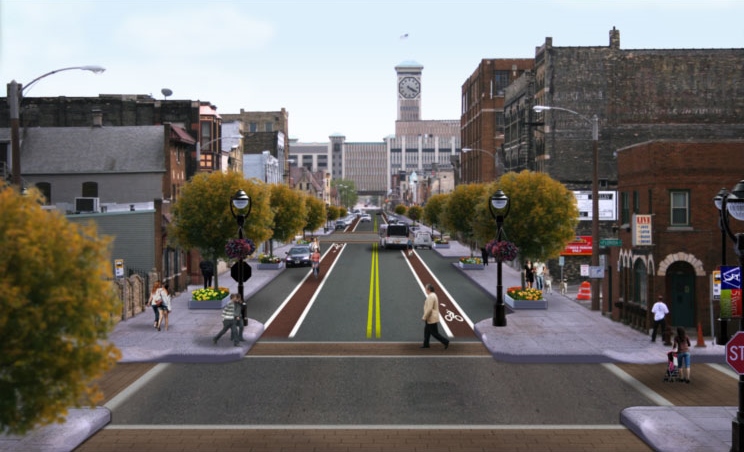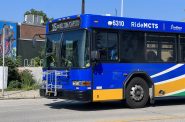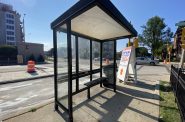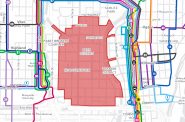Feds Pursuing Complete Streets
A goal of safe and accessible roadways for all users isn't just a Milwaukee policy anymore.

This rendering of S. 2nd Street includes a variety of features of a “Complete Street.” Many, such as wider sidewalks, street trees and bike lanes, were incorporated in the streets reconstruction in 2010. Rendering by Kieran Sweeney.
The City of Milwaukee has a new ally in its quest to make its streets safe for not just motorists, but pedestrians, bicyclists and other road users, regardless of age or ability.
The Federal Highway Administration (FHWA) adopted a Complete Streets policy in 2021, joining one adopted by the City of Milwaukee in 2018.
Given a surge in fatalities amongst road users of all kinds, Congress requested the U.S. Department of Transportation adopt the design model as part of a 2021 funding appropriation.
Seventy percent of the roads in the FHWA-funded National Highway System (NHS) are not limited-access freeways where the concept can’t be reasonably applied. In Milwaukee, NHS-designated highways include a number of arterial streets: Prospect, Farwell, North, National and Oklahoma avenues, Brown Deer Road, Capitol Drive and 27th Street.
FHWA, in a 57-page report, has identified five areas of opportunity within its work: improving data collection and analysis, supporting rigorous safety development, accelerating adoption of standards and guidance on safety improvements, reinforcing the primacy of safety for all users and making Complete Streets the default approach.
In its analysis of challenges facing Complete Streets implementation, FHWA notes it needs cooperative partners. “Many state and local agencies prioritize reducing traffic congestion, which can conflict with the goal of providing safe facilities for all users,” says the report. It also states that agencies have placed an emphasis on risks of increased congestion while discounting benefits from other transportation modes.
The report says that many federal funding programs, one of the key tools for FHWA and USDOT to influence transportation policy, do not include specific safety analysis requirements. The one that does, the Highway Safety Improvement Program, makes up only 6% of all federal roadway funding.
Local Implementation
Milwaukee has seen success in implementing some Complete Streets approaches, but Department of Public Works (DPW) officials have warned that it will take years to see substantial changes given the long design and construction time in major projects.
But the policy has found its way into a number of smaller projects. This spring, DPW is poised to make a mix of rapid implementation improvements to 16 corridors. Those projects will build on past efforts that included placing concrete planters and plastic delineators in the parking lane to prevent illegal passing known as “the Milwaukee slide” and narrowing travel lanes in an attempt to slow traffic speeds.
An analysis by Smart Growth America of the 66 Complete Streets policies passed in 2018 found Milwaukee’s policy the third strongest.
The way pre-existing U.S. and Wisconsin policy is structured to require only “consideration” of bicycle and pedestrian facilities is cited as a challenge in the FHWA report, given that what “consideration” actually means is undefined.
City officials, as recently as late February, have cited challenges in negotiating with state officials to be able to place traffic calming features into state highway projects. Many of Milwaukee’s arterial streets, including W. Capitol Dr., which is to receive curb bump-outs under a new proposal, are designated as state highways.
Wisconsin previously had a more robust policy, but it was repealed under Governor Scott Walker.
The 2021 Bipartisan Infrastructure Law calls for states and metropolitan planning organizations to allocate at least 2.5% of their planning and research funds towards Complete Streets efforts.
Transportation
-
MCTS Adds 28 New Buses
 Jul 13th, 2024 by Graham Kilmer
Jul 13th, 2024 by Graham Kilmer
-
MCTS Designing New Bus Shelters
 Jul 10th, 2024 by Graham Kilmer
Jul 10th, 2024 by Graham Kilmer
-
MCTS Updates RNC Bus Detours To Better Serve Downtown, Riders
 Jul 9th, 2024 by Jeramey Jannene
Jul 9th, 2024 by Jeramey Jannene





















